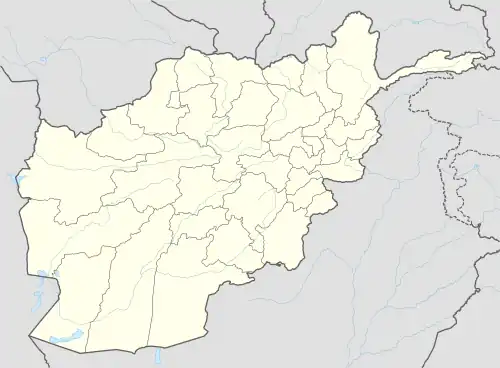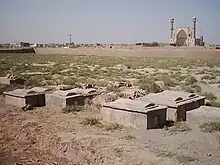| Yu Aw Synagogue | |
|---|---|
| Religion | |
| Affiliation | Orthodox Judaism |
| Status | Abandoned |
| Location | |
| Location | Momanda |
 Shown within Afghanistan | |
| Geographic coordinates | 34°20′21″N 62°11′12″E / 34.3391°N 62.1866°E |
| Architecture | |
| Style | Persian |
| Specifications | |
| Direction of façade | West |
| Materials | Mud brick |

The Yu Aw Synagogue (Persian: کنیسای یوآو) is located in the Momanda neighbourhood of the old city of Herat, in western Afghanistan. The area was once known as Mahalla-yi Musahiya, or the "Neighbourhood of the Jews". It is the only synagogue in Herat that has been preserved with most of its original characteristics, although it is currently in a state of disrepair.[1] There is no definitive date of construction of the synagogue. When Israel was founded in 1948, the estimated 280 Jewish families that lived in Herat began leaving. As of 2021, there are no Jews in Afghanistan.[2][3]
In 2020, Al Jazeera reported that part of the complex was restored by the local government in 2009.[4] It is the only synagogue in Herat that has been preserved with most of its original features. Although badly damaged, it was recently converted into an infant school. There are 3 other synagogues in Herat,[5] in a more advanced state of disrepair, two had been converted to schools and one to a mosque.[6] Not far from the synagogue there is still a mikvah (ritual bath) formerly called Hamman-e Yahudiha, which has been converted into a hammam for Muslim men. There is also a Jewish cemetery that contains around 1,000 graves.[3]
Description
The remains of the building on the east, north and south sides of the courtyard are now used as family housing. A room in the basement of the structure on the west side of the courtyard is used for housing by one of the employees of the Herat Department of Historic Monuments Preservation. The remainder of the building is in a precarious condition. Annette Ittig's report does not date the synagogue.[7]
A preliminary survey carried out by Annette Ittig in 1998 noted that:
The main prayer hall still has much of its painted stucco decoration, which is primarily floral, with a strong Persianate influence, e.g. the flowering "trees of life" and the butas, or paisley motifs, set to either side of the Torah Ark on the western wall.... The ark is elevated and is reached by stairs. The room itself is octagonal in shape.... On the south side of prayer hall is an arcade with a partition with small decorative openings that served as the women's gallery. The low open bimah, which is placed below the central dome, remains intact.... There are three Hebrew inscriptions on the north wall above the stairway....[8]
Restoration
The synagogue was restored in 2009 with funding from Swiss NGO Aga Khan Trust for Culture. Restoration of the interior blue, hand-painted dome by local craftsmen was funded by the Islamic Republic of Afghanistan, but all but stopped after the government's fall during the 2021 Taliban offensive.[9]
However, in October 2022, the Taliban-run Islamic Emirate of Afghanistan announced a 16-month project to prevent the synagogue's structural collapse and to rehabilitate the community's mikveh. Most of the $500,000 cost is being funded by the Aliph Foundation.[10]
See also
References
- ↑ "The Yu Aw synagogue in Herat". International Survey of Jewish Monuments (ISJM). Retrieved 2011-08-25.
- ↑ Afghanistan's last Jew leaves country, theguardian.com. Accessed January 8, 2024.
- 1 2 Golnar Motevalli (2009-06-24). "Relics of old Afghanistan reveal Jewish past". reuters.com. Retrieved 2020-08-21.
- ↑ Herat’s restored synagogues reveal Afghanistan’s Jewish past
- ↑ "Muslim trust restores Jewish sites in Afghanistan". Reuters. Archived from the original on June 26, 2009. Retrieved 2020-08-21.
- ↑ "Research on Afghan Synagogues". www.isjm.org. Archived from the original on 2001-05-19.
- ↑ "International Survey of Jewish Monuments: The Yu Aw synagogue in Herat, Afghanistan". Isjm.org. Archived from the original on 2011-09-01. Retrieved 2011-08-25.
- ↑ Ittig, Annette (April 5, 2005). "Documentation of Afghanistan Synagogues". International Survey of Jewish Monuments. Retrieved 2007-05-29.
- ↑ Rosenfeld, Arno (2021-08-17). "As Taliban take charge, uncertain future for Afghanistan's Jewish heritage sites". The Forward. Retrieved 19 July 2023.
- ↑ Jackie, Hajdenberg (2022-10-27). "Taliban approves conservation work on historic Afghan synagogue". Jewish Telegraphic Agency. Retrieved 19 July 2023.